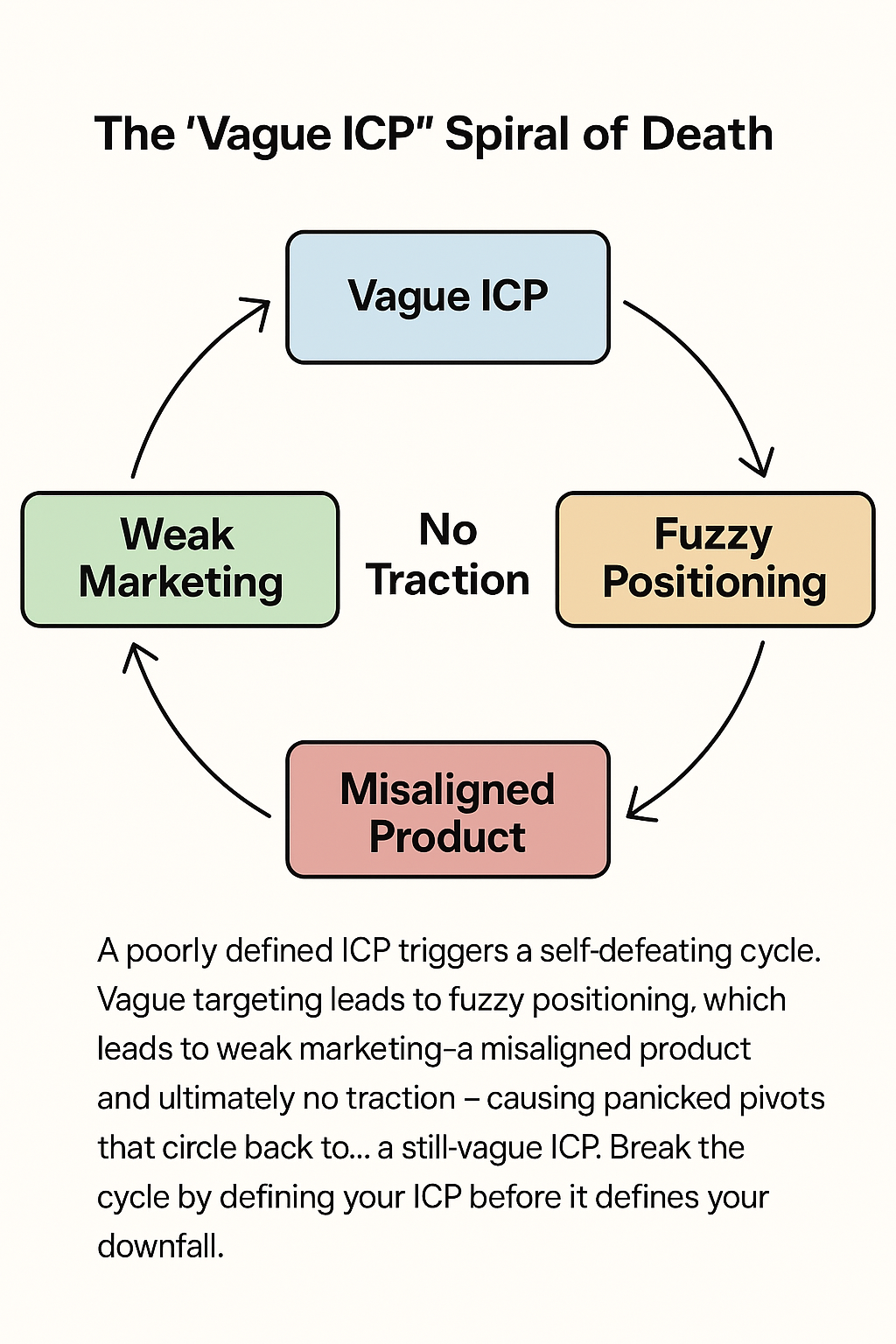Guessing is Not a Successful Sales Strategy. Create an ideal customer profile instead.
Think your product is “for everyone”? That’s cute. It’s also a ticket to early stage startup hell.
One of the top reasons startups fail (42%!) is building something nobody actually needs. Translation: they never clearly defined who their real customer was. In startup post-mortems you’ll hear the haunting refrain: “no market need.”
An Ideal Customer Profile (ICP) is the antidote to that fate. It’s the crystal-clear picture of who truly needs what you’re selling. An ICP helps in qualifying leads effectively, ensuring your sales and marketing teams focus on the target audience.
Without it, you’re basically playing darts blindfolded and hoping for a bullseye. Spoiler: that approach rarely ends with a high score. Defining an ICP helps identify the right customer for your business, allowing you to target the most lucrative customers and allocate resources efficiently.
Let me risk being provocative: if you haven’t nailed your ICP, nothing else you do matters. Your marketing? Shots in the dark. Your product roadmap? Built on quicksand. Your team? Acting on impulse.
Early-stage founders, this article is the tough-love wakeup call to stop winging it and start obsessing over your ICP – with a side of humor and real-talk to make it go down easy. Some might even call it the complete guide to ideal customer profile development - but I'm not a fan of hyperbole ;).
What the Heck Is an ICP (and Why Should You Build an Ideal Customer Profile)?
Ideal Customer Profile (ICP): fancy term, simple concept. It’s a detailed description of the perfect-fit customer for your startup – the kind of customer who desperately needs your products or services, happily pays for it, and sticks around.
Think of your ICP as the bullseye on a target. Everything in your business – your unique selling proposition, your marketing copy, your sales pitch – should be aimed dead-center at that bullseye. If you don’t know exactly who you’re aiming for, you end up spraying arrows everywhere and hitting nothing. Account based marketing (ABM) uses ICPs to focus on potential customers most likely to convert.
Imagine trying to write a love letter but addressing it “To Whom It May Concern.” That’s what marketing without a clear ICP looks like. As I'm known to say, none of the shiny growth hacks or new marketing tools will save you “if you don’t nail the basics first”. And the most basic of basics is knowing exactly who you’re building products or services for. So let's agree, you need to create an ideal customer profile.
Your ICP defines the audience that will find your product indispensable. It’s not just a customer – it’s the ideal customer. When you zero in on them, every part of your business starts to click into place. Asking ideal customer profile questions helps uncover insights about customer needs, refining your marketing strategies and identifying valuable prospects.

Understanding Best Customer Profiles and Buyer Personas
Understanding customer profiles and buyer personas is like having a secret weapon in your startup arsenal. These tools are crucial for crafting marketing and sales strategies that hit the mark every time. But what exactly are they?
A customer profile is a detailed description of a company that perfectly fits your product or service. Think of it as the blueprint of your dream client – the one who not only needs what you’re selling but also values it enough to stick around. On the other hand, a buyer persona is a semi-fictional representation of the individuals within those companies. It accounts for demographics, goals, motivators, and challenges. Essentially, it’s like creating a character in a novel, but this character is your ideal customer.
Both customer profiles and buyer personas are essential for understanding your ideal customers. They help you create content and campaigns that resonate deeply, prioritize leads, and focus your efforts on those most likely to convert. Imagine trying to sell accountancy software. Your customer profile might be small to medium-sized businesses, but your buyer persona could be the CFO who’s drowning in spreadsheets and desperately needs a streamlined solution.
By nailing down these profiles and personas, you’re not just shooting in the dark. You’re crafting a laser-focused strategy that speaks directly to the people who matter most. So, take the time to build these profiles and personas – your marketing and sales teams will thank you.

Rookie ICP Mistakes (Yes, We’ve All Done Them)
Defining an ICP sounds obvious, yet founders routinely screw it up. Let’s highlight a few face-palm misconceptions and rookie mistakes:
“Our product is for everyone!”
– Ah, the classic. If you’re tempted to say anyone could use your product, step away from the pitch deck. An ICP that broad isn’t ideal at all – it’s a blob. Saying “we sell to small businesses” or “anyone who needs accounting software” is as good as saying “we have no clue who our customer is”. Newsflash: “We sell to SMBs” is not an ICP – it’s a cop-out. Startups who chase “everyone” often end up with no one.
Too Vague to Matter:
Maybe you have some definition, but it’s squishy: e.g. “business owners who want to be more efficient.” That’s a fortune cookie, not an ICP. If your ICP description could fit a corner bakery and a SaaS unicorn, it’s too broad. Overgeneralizing your ICP – like saying “any B2B company” – feels inclusive but it’s a recipe for wasted time and crappy leads. Ignoring existing technology usage can lead to a vague ICP that doesn't align with the specific needs of potential clients. (You’ll end up pitching to lots of tire-kickers who will never buy. Fun.)
Assuming Instead of Knowing:
Many founders just guess who their ideal customer is, often projecting their own persona. (“Our buyer is probably a tech-savvy millennial on TikTok… because I am.”) This is building on anecdotes and ego, not evidence. As one growth expert notes, too many teams think they “know” their ICP without real data, or cling to an outdated idea of their ICP while the market shifts.
That’s how you get painful surprises when your product doesn’t resonate – you were aiming at the wrong target all along. Additionally, considering legal or contractual limitations is crucial to ensure your solutions fit within the constraints of potential clients.
Fear of Narrowing (FOMO ICP):
Defining a narrow ICP can be scary – “but what about all those other people who might buy? We don’t want to exclude anyone!” This fear of missing out leads founders to keep the ICP loose… and then convert almost no one. It’s counterintuitive: by trying to appeal to everybody, you appeal to nobody. Meanwhile, a precise ICP feels like you’re limiting potential, but it actually amplifies your message to those who matter. Don’t worry about the ones you leave out; worry about delighting the ones you leave in.
How a Flimsy ICP Wreaks Havoc on Your Startup
Still not convinced that nailing your ICP is mission-critical? Let’s look at the fallout when you get it wrong. A poorly defined ICP doesn’t just sit quietly—it wreaks havoc across your startup:

Muddled, Weak Marketing:
If you’re unclear on who you serve, your marketing copy will sound like a fifth-grader’s generic essay. You’ll end up with fluff like, “We help businesses improve productivity,” which speaks to absolutely no one. Broad ICP → broad message → no resonance. Prospective customers skim your site and think, “Meh, they don’t really get my problem.”
Bad ICP is often the invisible culprit behind those dismal click-through rates and crickets chirping on your landing page. Additionally, a poorly defined ICP can lead to misalignment between the customer success team and sales team, causing further inefficiencies.
Fuzzy Positioning & Brand Identity:
Your brand can’t be “the go-to solution for everything.” But without a clear ICP, you’ll try. You’ll constantly tweak your tagline, oscillate on what value to highlight, and confuse the heck out of the market. One week you’re “the platform for creators,” the next you’re “the ultimate SMB tool,” and nobody (including you) knows what you stand for.
This kind of identity crisis comes directly from ICP confusion (or lack thereof). It’s hard to become the "X for Y" when you haven’t nailed who Y is.
Bad Product Decisions:
Ever find yourself shoveling in feature after feature because someone out there requested it? That’s what happens sans ICP. You’ll chase random feedback and edge-case requests, bloating your product with a Frankenstein mix of features that don’t delight any one user.
A fuzzy ICP means you don’t know whose problem to prioritize, so you try to solve everyone’s problem (and end up solving none well). Result: a product that’s mediocre to all, amazing to none. As the saying goes, when you build for everyone, you build for no one.
Wasted Time and Money:
Here’s the cruel kicker – all the above means you’re burning precious resources. Your sales team wastes time chasing “new leads” that never convert, because they were never the right fit in the first place. Your marketing team burns cash on marketing efforts that get lots of clicks but zero customers, because you targeted the wrong eyeballs. You might even close a few deals with misfit customers, only to see them churn in a flash when they realize it’s not for them, destroying your customer lifetime value.
In short, a bad ICP drains your startup’s lifeblood – time, money, morale – and gives nothing in return. Analyzing existing customers can help refine the ICP, avoid wasted resources and land future customers, while informing future solutions or ongoing support.

Aiming True: How a Well-Defined ICP Supercharges Your Startup
Enough doom and gloom – let’s talk about the good that happens when you nail building an ideal customer profile. A well-crafted, specific ICP is like a cheat code for startup traction.
Here’s what sharp ICP focus does for you:
Laser-Focused Marketing (That Actually Works):
When you truly understand your ideal customer, you can speak their language and address their pain points with uncanny precision. Your copy goes from generic drivel to “holy crap, were they reading my diary?!” For example, instead of blandly shouting “We help small businesses succeed,” you can say “We help 2-5 person creative agencies keep their clients from churning.” The latter makes your target customer feel seen and understood. Suddenly, your emails get replies, your ads get clicked, and your content sparks nods instead of snores from potential customers.
Sharper Positioning & Brand Identity:
With a clear ICP, you know exactly whose world you’re trying to rock. That clarity seeps into your branding and positioning. You stop trying to be everything to everyone and become the go-to solution for your best customers. If your ICP is, say, “regional restaurant owners who struggle with staff scheduling,” you position yourself unequivocally as the staff scheduling hero for independent restaurants. That focus makes your brand memorable. It’s immediately clear who you serve and why you’re different. You want people to hear your company name and think, “Oh, they’re for people like me.” A tight ICP lets you achieve exactly that. You'll be able to add exactly the right details, not just more details.
Efficient Sales and Outreach:
Ever had a sales call where the prospect says, “I feel like you really get my business”? That’s the magic of ICP alignment, and yields the best customers. Knowing your ICP means you can laser-target your outreach to the channels they actually use, with messaging that hits home. You won’t waste time cold-calling randos or pitching to the wrong crowd. Instead, you’ll focus on high-probability prospects who fit your ICP profile to a T. Sales cycles shorten, close rates climb, and you stop hearing “I’m not sure this is for me,” because you’re only talking to people for whom it absolutely is for them. In fact, a well-defined ICP can turn your sales team into a heat-seeking missile, zeroing in on the best customers and ignoring the rest (politely).
Clear Product Roadmap & Faster Traction:
A defined ICP acts like a compass for product development. When you know the specific needs, frustrations, and goals of your ideal customers, you prioritize building the features that make them say “take my money!” This discipline keeps you from chasing feature creep or trendy ideas that don’t serve your core users. The outcome? Your product actually delivers a knockout punch for a particular buyer personas. And when an ideal customer tries it, they get value quickly – because you built it explicitly for them. They become loyal users, maybe even raving fans.
Early traction builds as more of your ICP find you, love you, and spread the word. It’s the classic niche startup playbook: dominate a niche, then expand outward. You get there by doubling down on your ICP, not diluting it.
Gathering Customer Feedback
Gathering customer feedback is like mining for gold – it’s essential for creating effective customer profiles and buyer personas. This feedback provides invaluable insights into the behavior and preferences of your ideal customers, helping you understand their needs and challenges on a deeper level. It will also help you understand the difference between ideal customers and those that ~suck~ are less than ideal customers.
There are several ways to gather this precious feedback. Surveys, interviews, and focus groups are classic methods that allow you to hear directly from your customers. But don’t stop there. Dive into your customer data to uncover patterns and trends. Analyze how your customers interact with your product or service, what features they love, and where they encounter pain points.
By combining direct feedback with data analysis, you can create a comprehensive picture of your ideal customer. This, in turn, allows you to craft targeted marketing and sales strategies that truly resonate. Remember, the more you understand your customers, the better you can serve them. So, make gathering and analyzing user feedback a regular part of your business routine. Your ideal customers are out there – you just need to listen to what they’re saying.
Creating an ICP for a Brand New Business
Creating an Ideal Customer Profile (ICP) for a brand new business can feel like trying to hit a bullseye in the dark. Without existing customer data to draw from, where do you even start? Don’t worry – it’s entirely possible to create an effective ICP from scratch.
First, dive into market research. Analyze industry trends, competitor data, and any available feedback. This will help you paint a picture of your target audience, including their demographics, goals, motivators, and challenges. Think of it as detective work – you’re piecing together clues to identify your ideal customer's buyer persona.
Next, leverage online tools and resources. Social media analytics, customer surveys, and online reviews are gold mines of information. These tools can provide insights into your target customer segment behavior and preferences, helping you refine your ICP.
Finally, use your ICP to guide your marketing and sales efforts. Create targeted content and campaigns that speak directly to your ideal customers. By doing so, you’ll attract and retain ideal customers who truly value your product or service, driving revenue growth.
In conclusion, creating an ICP is essential for any business, new or established. By understanding customer profiles and buyer personas, gathering feedback from customer segments, and conducting thorough market research, you can build a solid foundation for your marketing efforts and sales strategies. So, roll up your sleeves and get to work – your ideal customers are out there, waiting to be discovered.

Show Me the Difference: Bad vs. Good Messaging Examples
To drive this home, let’s walk through a vivid before-and-after of how refining your ICP sharpens your messaging:
Scenario: SaaS project management tool.
Bad ICP:*“Our target is small businesses.”* (Bleh, could mean anything.)
Bad Messaging: Homepage headline – “Project management made easy for businesses of all sizes.” 🥱 (Who is this even for? “Businesses of all sizes” = meaningless fluff. No specific pain addressed.)
Good ICP:*“Owners of boutique marketing agencies (< 10 employees) who are overwhelmed by client projects and slipping deadlines.”*
Good Messaging: Homepage headline – “Finally, a project tracker built for busy agency owners juggling dozens of client deadlines.” 🔥 (Speaks directly to a scenario the ICP lives daily. An agency owner reads this and thinks, “Yes! That’s me.”) A successful marketing strategy targeted at this ICP can significantly improve messaging and engagement.
Scenario: B2C fitness app.
Bad ICP:*“People who want to get fit.”* (Captain Obvious would be proud.)
Bad Messaging: Instagram ad – “Get in shape with our awesome fitness app.” (Generic, yawn. Every fitness app ever says this.)
Good ICP:*“New moms in their 30s who want quick at-home workouts to regain energy.”*
Good Messaging: Instagram ad – “Hey moms: Recharge in 20 minutes! Home workouts designed for postpartum energy and strength.” (Highly specific and relatable to the target user’s life stage and need.) Identifying valuable customers like these new moms is crucial for crafting effective messaging.
See the pattern?
Specificity wins. The bad messaging could apply to anyone, so it speaks to no one. The good messaging is laser-targeted, dripping with context that only the ICP would care about. Sharper ICP → sharper message → “shut up and take my money” moments from perfect customers.
Use the ICP Workbook: Stop Guessing, Start Knowing with an Ideal Customer Profile Template
Alright, so you’re fired up to refine your ICP – but how exactly do you do it? Don’t worry, we’ve got you covered. We’re offering a free interactive ICP workbook template that guides you step-by-step through defining your Ideal Customer Profile. It’s like Mad Libs for nailing your target customer (minus the nonsense). This workbook will prompt you to specify things like: industry, company size, key pain points, motivators, deal-breakers, and more. It helps you distill all your customer research, hunches, and insights into a one-page ICP that you can share with your team and tape to your wall. Additionally, the workbook includes a worksheet template to answer key questions about your ICP systematically.
Why an interactive workbook? Because defining an ICP isn’t a one-time scribble; it’s an iterative process of discovery. Our template gets you asking the right questions – Who benefits the MOST from our solution? Who’s scrambling for a fix to the problem we solve? What does “a day in the life” look like for them? By the end, you’ll have a concrete profile you can use to test your assumptions (and yes, you should go out and talk to real humans to validate it!). The workbook is totally free because we’d rather you get it right early than become another sad startup statistic. Use it, refine it, and refer back to it often as you learn more. Also, remember to gather key stakeholders together from various teams, such as customer success, sales, and marketing, to collaboratively define your ICP. This collaborative effort ensures a well-rounded approach to understanding customer needs.

Conclusion: No More Mystery Customers – Define Your ICP Now
Early-stage founders, consider this your friendly but firm kick in the pants. Stop trying to boil the ocean by targeting “anyone with a wallet.” The fastest way to go nowhere is to try to be everything to everyone. Instead, get hyper-specific. Plant your flag in the ground and say, “We are building for this kind of customer, and we know them inside and out.” Yes, you might feel you’re narrowing your market, but you’re actually clarifying it. And clarity is gold.
Your Ideal Customer Profile is the foundation upon which startups are built (or broken). When you know your ICP, you can wake up every day laser-focused on delighting those people. When you don’t, you’re just throwing spaghetti at the wall. So take the time now to define and refine your ICP. Grab our free ICP workbook, fill it out, and use it. Rally your team around it. Make it your north star for every decision – from product features to marketing efforts.
It’s time to stop guessing who you’re building for and start knowing. Nail your ICP, and you’ll stop chasing random prospects and start attracting your ideal customers like moths to a flame. Your messaging will sharpen, your product will hit the mark, and your early traction will actually mean something. In short, you’ll move from a startup shot in the dark to a startup with a target lock-on.
Ready to ditch the guesswork?
Grab the ICP workbook and get to work – your ideal customers are waiting. \ \ Click here for the ICP Workbook (it’s a Notion template, simply click to duplicate it in your own Notion).
About the Author
Ryan Rutan
Founding Partner @ Startups.com platform | Clarity.fm, Launchrock, Fundable, Zirtual, and Co-Host of The Startup Therapy Podcast. Ryan has 15 years of experience as a Founder, Advisor, Mentor, and Investor — the quintessential startup guerrilla. He works with 100's of the best startups every year on everything from ideation, idea validation, early marketing traction, customer acquisition to fundraising, scaling, and operations.
Related Articles
Unlock Startups Unlimited
Access 20,000+ Startup Experts, 650+ masterclass videos, 1,000+ in-depth guides, and all the software tools you need to launch and grow quickly.
Already a member? Sign in